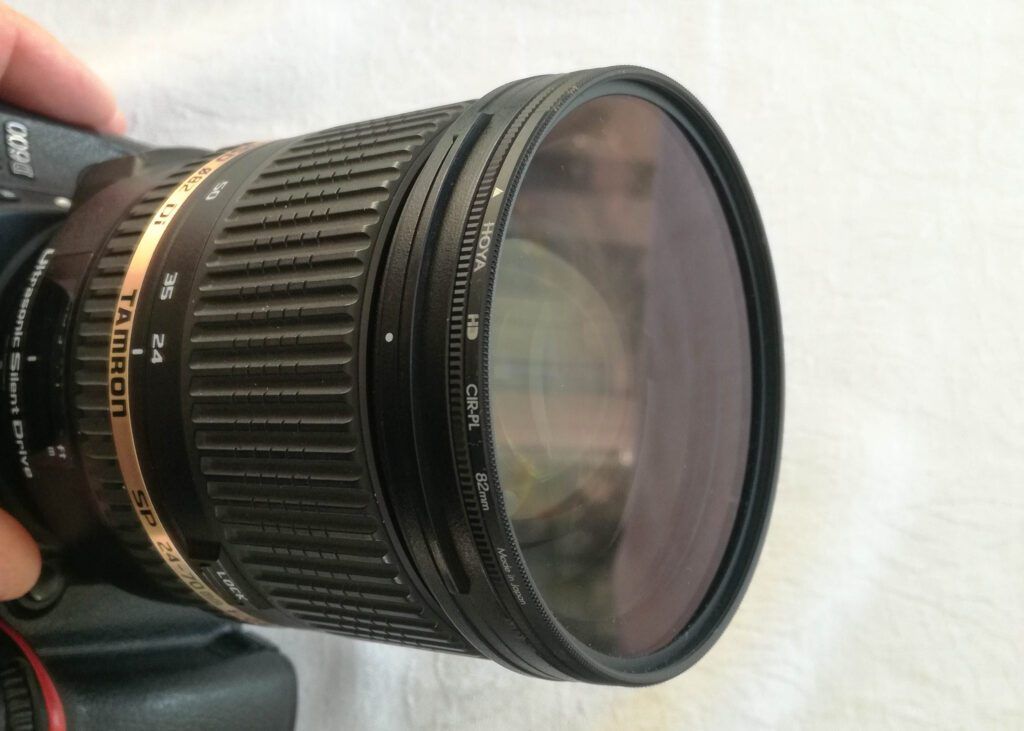I’m sure that you have encountered a situation at least once, where you have been frustrated by glare/reflections hitting your lens from a body of water, glass, or perhaps another object. When you looked back at your affected images, then you realized that had it not been for the glare, these images would have been awesome.
The frustration was supplemented even further by embarrassment when you had to explain to your (perhaps paying) subjects why these images were not included in the collection at the delivery date.
Well, I have good news for you. There is a solution that, if not removing all of the glare from an image at the time of the shoot, will remove at least some (or most) of the glare. It is called a Circular Polarizer or a Linear (CPL) filter.
What will you learn in this guide?
In this guide, we will have a look at polarized light, including what it is and why we need to polarize it. We will look at how to achieve this using a Circular Polarizer/Linear (CPL) filter.
Note: Light is a very technical phenomenon and so is the polarization thereof. The purpose of this guide is to look at the polarization of light in very simple terms. I will thus not attempt to bedazzle you with technical terms and phenomena, as easy as that may be.
Recommended Reading: If you’re interested in learning more about light and how you can use it to improve your photography, grab a copy of Photzy’s bestselling premium guide: Understanding Light Book Two.
Our view of polarized light may thus be somewhat incomplete as we will focus more on the results rather than on the science behind it.
What Is Light?
Before looking at polarized light, let’s look at a few facts about light itself:
- Light travels in waves
- Some light waves (e.g. infrared, microwave, radio waves) are too long to see with the naked eye
- Some light waves (e.g. ultraviolet, x-ray, gamma rays) are too short to see with the naked eye
Light consists of two waves oscillating perpendicular to one another. That means if one wave oscillates vertically, then the second will oscillate horizontally. One wave is an oscillating electric field and the other is an oscillating magnetic field. It should come as no surprise then that light is also known as electromagnetic waves.
These electromagnetic waves are produced by vibrating electric charges.
Light is unpolarized by default. That implies that the direction of electromagnetic waves fluctuates randomly in time.
Key Lesson: Light is an extremely complex phenomenon. We can make it as complex as we want to, but we only need to know a little about it to understand the effect of polarization. Let’s not overanalyze it and rather focus on the results achieved using a polarizing filter plus how to do so.
What Is Unpolarized Light?

Unpolarized light. No CPL filter was used. The driver is vaguely recognizable. Photograph by Tobie Schalkwyk
Unpolarized light vibrates in multiple planes. An example of this is a lamp. It creates electromagnetic waves that vibrate in all directions.
The intensity of unpolarized light depends on the nature of its source.
Unpolarized light is produced by reflections or travels through a material. This is visible as glare (reflected) or a color cast (after traveling through another medium).
What Is Polarized Light?
Polarized electromagnetic waves are light waves in which the vibrations occur in a single plane (all waves vibrate in the same direction). This is in contrast to unpolarized light which vibrates in multiple planes.
The intensity of polarized light depends on the nature of the polarizer used.
The light produced by natural sources (like the sun) is always polarized.

CPL filter used to its maximum. The driver is 100% recognizable and the image is softer on the eye in general. Photograph by Tobie Schalkwyk
Key Lesson: Light is produced in two basic forms: polarized (straight from a natural source) or unpolarized (reflected or ‘spread’ by a medium it travels through). Sometimes we wish to polarize it to remove glare or to produce ‘cleaner’ (dehazed or more vibrant) images.
In general, polarized light is ‘easier’ on the eye and more attractive. This is the reason we wear polarized sunglasses.
Why Would I Want To Polarize Light Before It Hits My Camera’s Sensor?

The effect of the CPL filter can be seen (the right half). Saturation is better in general, and the sky has changed from dull to a beautiful blue. Photograph by Tobie Schalkwyk
Well, unless you need some artistic effect, the nature of unpolarized light (visible as reflections or glare) implies that it might spoil your image. A polarizer gets rid of all reflected light waves (or glare) by only letting light through on a single plane.
Other benefits of polarizing filters include:
- it increases color saturation;
- it reduces haze; and
- it produces beautiful blue skies and darkened clouds.
Polarizing Filters
A polarizing filter is a great little masterpiece. It is created by sandwiching a dichroic absorbing layer (made of PVA plastic) between two layers of glass. This PVA layer is stretched until its molecules line up in long parallel polymer chains with tiny gaps between them.
A polarizing filter is a great little masterpiece.
The stretched PVA layer is then dipped into iodine and the iodine molecules attach themselves to the polymer chains. This allows the resulting pola foil to absorb light waves that are parallel to the polymer chains while letting through waves that are perpendicular to these chains.
If you have believed that a CPL is too expensive, just look at the technology and science behind it and think again! It’s great value for money!

The reason why round CPL filters are so popular (and worth the investment) is that it becomes part of your lens. Note the small ridges on the filter’s frame, making it easy to screw onto the lens or unscrew it. The front (smooth) part holds the filter and is rotated to achieve the desired effect. Photograph by Tobie Schalkwyk
Polarizers are divided into two groups:
1. Linear Polarizers
These polarizers:
- are excellent in reducing glare (e.g. camera filters and polarized sunglasses);
- can be used to control the intensity of a light source, which is done by placing a second polarizer on top of the first and then rotating one against the other;
- transmit light vibrating in a single plane while absorbing the orthogonal plane; and
- are cheaper than circular polarizers.
2. Circular Polarizers
These polarizers:
- are more expensive than linear polarizers;
- are needed with any camera that has through-the-lens metering systems or autofocus. The reason is that these systems use semi-silvered mirrors to filter out some of the light coming through the lens. If such light is linearly polarized, it renders both metering and autofocus ineffective, and its cross-polarization effect can actually blackout your image.
The circular polarizer has a second layer inside the filter, called a Quarter Wave Plate. This filter ‘spins’ the light after it goes through the linear layer before it goes through the camera lens. This eliminates the cross-polarization effect on your camera’s mirror.
“Can I thus use the cheaper (non-circular) linear polarizer filters on my mirrorless DSLR camera?” Yes, indeed. It appears, however, that it is so difficult to get high-quality linear polarizer filters that most photographers hang on to their (by default higher quality) circular polarizer filters for use with their mirrorless DSLRs.
Key Lesson: Polarizers in two basic forms are important to photographers: linear and circular. Linear polarizers do most of the work as desired by us. Circular polarizers are linear polarizers with a quarter-wave plate on the ‘inside.’
The quarter-wave plate is needed to ‘spin’ polarized light before it reaches the mirrors of our DSLR cameras; otherwise, these mirrors may filter out all polarized light, leaving us with unusable/blank images.
Square or Round Polarizing Filters
The term ‘circular’ polarizing filter should not be confused with the shape of your filter. Circular Polarizing/Linear (CPL) filters can be purchased in both square and circular forms.
The advantage of a square CPL filter is that it can be shared between lenses having various lens diameters. The disadvantage is that it might be bulky and ‘in the way’ because it does not sit ‘flush’ with your lens’ round edges.
The advantage of the round CPL filter is that after screwing it into the front of your lens, it becomes part of the lens – almost ‘invisible.’ The lens cap even mounts directly onto the mounted filter, not only making it almost ‘invisible’ but also protecting the filter when not in use.
The second advantage of the round CPL filter is implied by the fact that the CPL filter has to be mounted in such a way that its quarter-wave plate layer is on the ‘inside,’ facing your lens. In round CPL filters, the quarter-wave plate layer is on its screw-in side, making it impossible to mount the wrong way.

The lens cap fits onto the CPL filter as the filter has the same diameter as the lens. Photograph by Tobie Schalkwyk
The disadvantage of around CPL filter is that it screws into the front of your lens. It is thus made for a particular lens diameter so you cannot share it with one of your lenses having a different diameter. A solution may be to buy a CPL filter for your largest lens diameter and mount it on any of your lenses utilizing step-up rings.
Another disadvantage of a round CPL filter is the price. They are generally more expensive than square filters.
Key Lesson: Both square and round CPL filters will do the job. The determining factor when buying it is how easy it is to use and the price. In general, round CPL filters are easier to use but they tend to be of higher quality than square filters, which makes them more expensive.
Which CPL Filter Should I Buy?
Just like any other commodity in the world, you get low-quality and high-quality CPL filters. In general, price is a good indication of quality, but understandably the bigger the diameter, the more expensive the filter.
Filter brands and models come and go so I’d recommend using Google to get an idea of the ‘best’ CPL filters on the shelf at any given moment. If you cannot afford the ‘best’ (probably most expensive) ones, try to avoid the cheapest ones and purchase one in the mid-price ranges.
In general, price is a good indication of quality, but understandably the bigger the diameter, the more expensive the filter.
Coatings
Some CPL filters offer water- and oil-repellent coatings, easily beading away droplets and resisting fingerprints.
Light Transmission
Some CPL filters incorporate high light transmission glass, letting light pass through by half a stop or more than filters without high light transmission glass. This can be quite important as the average CPL filter may reduce your light by up to two stops.
Vignetting
Low-quality CPL filters may produce unwanted vignetting effects.
Ease of Use
High-quality CPL filters will screw in smoothly into your lens and offer slick filter rotation. It will have grooves on its outside frame so it can be mounted/unscrewed easily.
Color Control
A low-quality CPL filter may produce a color cast into your image.
Key Lesson: The quality of a CPL filter is mostly determined by protective coatings, the amount of light it lets through, and possible vignetting effects. Do your homework (online) when shopping for one and buy the best you can afford. It will reward you greatly. Remember that unpolarized effects (defects) cannot be ‘fixed’ in post-processing.
Can I Mimic Polarization Effects in Post-Processing?
One can mimic quite a few filter effects in post-processing, but unfortunately, polarization is not one of them. An image is a two-dimensional entity, so post-processing software can’t remove glare and ‘guess’ what is supposed to be behind the removed glare.
How To Use a CPL Filter
The Position of the Sun
CPL filters produce the best results when the sun is sitting at 90° from the direction you are pointing your lens in. This can vary from 90° to your left, right above you, or 90° to your right (or anywhere in between).
Rotating the Filter
You will get different results based on how much you rotate your filter.
Note: The idea is not necessarily to get the maximum effect but rather to get the desired effect. Sometimes the maximum effect would not look pleasing to the eye, or you may want to retain a little bit of glare on a body of water (or window).
Recommended Reading: If you’re interested in learning more about light and how you can use it to improve your photography, grab a copy of Photzy’s bestselling premium guide: Understanding Light Book Two.
Look through your viewfinder as you rotate the filter and stop rotating when you achieve the desired result. If you find it impossible to get the desired result, the sun may be sitting at an unfavorable position relative to the direction your lens is pointing in (not at 90°).

No use of CPL filter. Photograph by Tobie Schalkwyk

The CPL filter rotated to its fullest effect. The 11:00 am the sun is slightly behind and above me. Photograph by Tobie Schalkwyk

The CPL filter rotated to its fullest effect. The 11:00 am the sun is 90° to my right and slightly above me. The amount of glare removed is significantly more than when the sun was behind me. Photograph by Tobie Schalkwyk

Photograph by Tobie Schalkwyk
More Examples
My purpose in this section is not to win any prizes, but to prove a concept. See what you can glean from it and apply it where needed.

No CPL filter was used. It’s almost impossible to see the portrait inside the house. The security gate is not in front of me but to my right. Its reflection is showing up on the glass of the sliding door between me and the portrait. Photograph by Tobie Schalkwyk

CPL filter used to its fullest. The portrait is much more visible, and the reflection of the security gate is only vaguely visible. Photograph by Tobie Schalkwyk
Self-Check Quiz:
- What is the visible difference between polarized light and unpolarized light?
- What are the sources of polarized light?
- How does polarized light become unpolarized?
- What is the ‘correct’ amount of polarization?
- What are the pros and cons of a round CPL filter?
- When would you want to use a CPL filter?
- Why would you want to use a circular polarizer filter?
- What is the function of the quarter-wave plate of a CPL filter?














